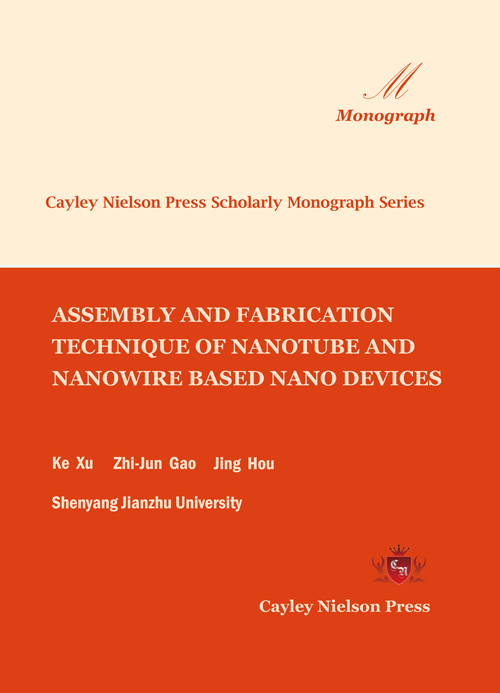
ASSEMBLY AND FABRICATION TECHNIQUE OF NANOTUBE AND NANOWIRE BASED NANO DEVICES

Ke Xu
Shenyang Jianzhu University
Zhi-Jun Gao
Shenyang Jianzhu University
Jing Hou
Shenyang Jianzhu University
Copyright © 2017 by Cayley Nielson Press, Inc.
ISBN: 978-0-9992443-4-0
Cayley Nielson Press Scholarly Monograph Series Book Code No.: 142-7-9
US$98.50
Preface
Nanotube and Nanowire with diameter of nanometer and other excellent physical properties are used to fabricate quantum dots and nano-scale field effect transistors for integrated nano-scale electronic devices. Those excellent properties of nanotube and nanowire always attract attention, which are mainly paid on electronic and chemical properties. Research on nanotube and nanowire’s dynamic tensile properties need precise dynamic operation of the nanotube and nanowire, which are one of the most difficult problems for nanowire properties research.
The controlled assembly and fabrication of nanotube and nanowire are a key challenge in the development of a range of bottom-up devices. The controllable fabrication of self-organized molecular layers on solid substrates is an important step towards integration of functional molecules into molecular devices. The self-assemblies of calixarene, metallosupramolecular compounds, organic semiconductors and the structural transition of supramolecular assembly under external stimuli have been revealed. Understanding of the driving forces behind the formation of molecular nano architectures through self-assembly process enables the rational design of nano-patterned, hierarchical molecular assemblies.
The contents of the book are organized into seven chapters. In chapter 1, the essential ideas of micro-scale manipulation by light-driven micro-robotics. In chapter 2, the essential ones of the assembly and fabrication of single CuO nanowire electronic device based on controllable DWS-DEP technology. In chapter 3, the essential ones of the assembly and fabrication of nanotubesandnanowires for electronic device. The chapter 4 is about the method to detect single-walled carbon nanotube-based gas sensors for NO2. In chapter 5, the essential ones of studying on rituximab binding force by AFM. The chapter 6 is about amicromanipulation system for single nanostructure material deposition using resistance. The last chapter is about the design of high-precision signal acquisition module in AFM.
I wanted to thank the authors of the book chapters, especially Meng-Xin Li, Chong Xu, Jing Liu, Ying Zhang, Wen-Feng Liang, Yu Ying, Mei-Ju Liu, Rui Zhang, Xi-Feng Guo, Xin Wang, Nan Hu, because they offered to nano materials and technology applied to many areas of the latest progress and the existing challenges.
KeXu
Shenyang Jianzhu University
Shenyang, Liaoning, China
July 24, 2017
Contents
1 Micro-scale Manipulation by Light-driven Micro-robotics
1.1 A Remotely Driven and Controlled Micro-gripper Fabricated from Light-induced Deformation Smart Material
1.1.1 Introduction
1.1.2 Materials and methods
1.1.3 Experimental results
1.1.4 Analysis and discussion
1.1.5 Conclusion
1.2 Miniaturized Swimming Soft Robot with Complex Movement Actuated and Controlled by Remote Light Signals
1.2.1 Introduction
1.2.2 Light-driving material
1.2.3 Swimming robot with gripper
1.2.4 Results and discussion
1.2.5 Materials and Method
2 Assembly and fabrication of single CuO nanowire electronic device based on controllable DWS-DEP technology
2.1 Introduction
2. 2 Preparation and Dispersion of CuO Nanowires
2.2.1 Preparation of CuO nanowires
2.2.2 Dispersion of CuO nanowires
2.3 Assembly of Single CuO Nanowire by Controllable DWS-DEP Technology
2.3.1 Theoretical analysis of controllable DWS-DEP technology
2.3.2 Assembly results by controllable DWS-DEP technology
2.4 Single CuO Nanowire Electronic Devices
2.4.1 Single CuO nanowire photodetector
2.4.2 Single CuO nanowire alcohol sensor
2.5 Conlusion
3 Assembly and Fabrication of NanotubesandNanowires for Electronic Device
3.1 Large-Scale Assembly and Fabrication Method for SWCNTs Nano Device
3.1.1 Introduction
3.1.2 Experimentalmaterials and method
3.1.3 Results and discussion
3.1.4 Conclusions
3.2 Large-Scale Assembly and Fabrication of Cu/CuO Nanowires for Nano-electronic Device
3.2.1 Introduction
3.2.2 Floating electrical potential large-scale assembly method and simulation
3.2.3 Experiment Materials
3.2.4 Experimental Results and Discussion
3.2.5 Conclusions
3.3 Study on fabrication method of Nanoelectrodes by shearing Carbon Nanotubes
3.3.1 Introduction
3.3.2 Experimental materials and sysytem
3.3.3 Result and discussion
3.3.4 Conclusions
3.4Investigation of Assembly Approach for InAs nanowire based Electronic Device
3.4.1 Introduction
3.4.2 Experimental materials and system
3.4.3 Result and discussion
3.4.4 Conclusions
4 Single-walled Carbon Nanotube-Based Gas Sensors for NO2 detection
4.1 Introduction
4.2 Experimental details
4.3 Results and discussion
4.4 Conclusions
5 Study on Rituximab Binding Force By Atomic Force Microscopy
5.1 Introduction
5.2 CD20 and rituximab
5.3 Materials and methods
5.3.1Materials
5.3.2 Sample preparation
5.3.3Tip functionalization
5.3.4 Fluorescence microscopy
5.3.5 Single-molecule force spectroscopy
5.4 Results
5.5 Conclusions
6 A Micromanipulation System for Single Nanostructure material Deposition Using Resistance
6.1 Introduction
6.2 Experimental materials and system
6.3 Results and discussion
6.4 Conclusions
7 Design of High-Precision Signal Acquisition module in Atomic Force Microscope
7.1 Introduction
7.2 Design of signal acquisition module
7.3 Acquistion module noise analysis and processing method
7.4 Signal acquisition module software design
7.5 Conclusions
References
Readership
This book should be useful for students, scientists, engineers and professionals working in the areas of optoelectronic packaging, photonic devices, semiconductor technology, materials science, polymer science, electrical and electronics engineering. This book could be used for one semester course on adhesives for photonics packaging designed for both undergraduate and graduate engineering students.
